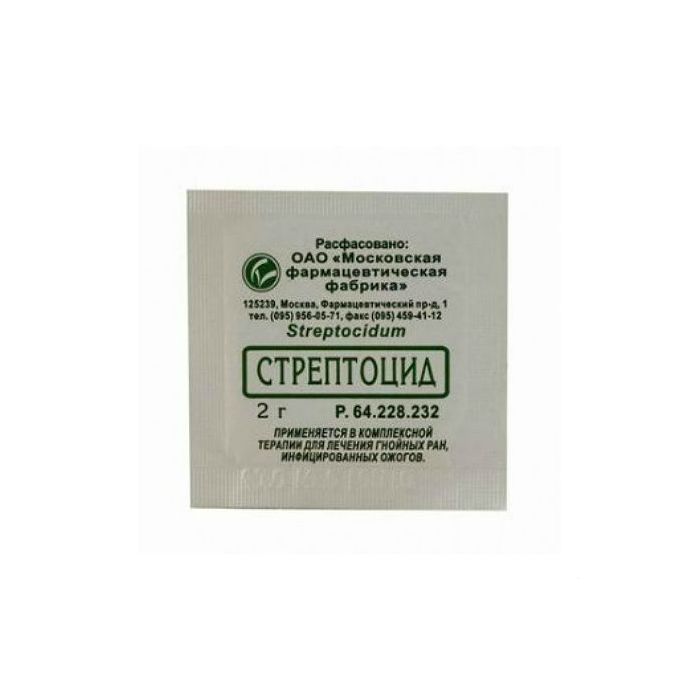sulfanilamide | Streptocide white powder 2 g
Special Price
$27
Regular Price
$34
In stock
SKU
BID494740
Release form
powder for external use
powder for external use
Release form
powder for external use
Packing
bag 2 g
Pharmacological action
Streptocide is a broad-spectrum antibacterial agent. Sulfanilamide (streptocide) is one of the first representatives of chemotherapeutic agents of the sulfonamide group. It has a bacteriostatic effect. The mechanism of action is due to competitive antagonism with PABA and competitive inhibition of the enzyme dihydropteroate synthetase. This leads to a violation of the synthesis of dihydrofolic and then tetrahydrofolic acid and, as a result, to a violation of the synthesis of nucleic acids.
Sulfanilamide is active against gram-positive and gram-negative cocci, Escherichia coli, Shigella spp., Vibrio cholerae, Haemophilus influenzae, Clostridium spp., Bacillus anthracis, Corynebacterium diphtheriae, Yersinia pestis, as well as in relation to Chlamydia spp., Actinomyces spp., Toiioplasma
Indications
Treatment of infections caused by susceptible microorganisms:
- sepsis
- meningitis
- disseminated Lyme borreliosis (early and late stages of the disease)
- infections of the abdominal cavity (peritonitis, wound infections (prevention and treatment).
Contraindications
Hypersensitivity,
anemia,
renal / hepatic insufficiency,
congenital deficiency of glucose-6-phosphate dehydrogenase,
azotemia,
lactation, sperlkrprf period, pregnancy.
Special instructions
Use with caution in patients with impaired renal function. During the treatment period, it is necessary to increase the amount of fluid consumed.
If hypersensitivity reactions occur, treatment should be discontinued.
With prolonged treatment, systematic monitoring of the blood picture, kidney and liver function is recommended.
Dosage and administration
Inside adults - 500 mg-1 g 5-6 times a day for children under 1 year old - 50-100 mg, from 2 to 5 years old - 200-300 mg, from 6 to 12 years old - 300- 500 mg per dose.
Maximum doses for adults when taken orally: single 2 g, daily 7 g.
For external use, apply to affected areas of the skin and mucous membranes. Dressings are performed in 1-2 days.
Side effects
From the digestive system: nausea, vomiting, diarrhea.
From the hemopoietic system: rarely - eosinophilia, thrombocytopenia, leukopenia, hypoprothrombinemia, agranulocytosis.
From the side of the central nervous system and peripheral nervous system: in isolated cases - visual impairment, headache, dizziness, peripheral neuropathy, ataxia.
Other: skin allergic reactions rarely - nephrotoxic reactions (most likely in patients with impaired renal function) In rare cases - hypothyroidism.
Drug interactions
Myelotoxic drugs enhance the hematotoxicity of the drug.
Overdose
Symptoms: nausea, vomiting, intestinal colic, dizziness, headache, drowsiness, depression, unconsciousness, visual impairment, fever, hematuria, crystalluria with prolonged hypotension, overdosage, overdose,
Treatment: copious drink by accidentally taking ointment and powder inside - gastric lavage.
Storage Conditions
In a dark place at a temperature not exceeding 25 РC.
Shelf life
3 years
Deystvuyushtee substance
Sulyfanilamid
dosage form
powder for external use
Appointment
Prescribing
For adults, For children prescribed by a doctor
Moscow pharmaceutical factory ZAO, Russia
powder for external use
Packing
bag 2 g
Pharmacological action
Streptocide is a broad-spectrum antibacterial agent. Sulfanilamide (streptocide) is one of the first representatives of chemotherapeutic agents of the sulfonamide group. It has a bacteriostatic effect. The mechanism of action is due to competitive antagonism with PABA and competitive inhibition of the enzyme dihydropteroate synthetase. This leads to a violation of the synthesis of dihydrofolic and then tetrahydrofolic acid and, as a result, to a violation of the synthesis of nucleic acids.
Sulfanilamide is active against gram-positive and gram-negative cocci, Escherichia coli, Shigella spp., Vibrio cholerae, Haemophilus influenzae, Clostridium spp., Bacillus anthracis, Corynebacterium diphtheriae, Yersinia pestis, as well as in relation to Chlamydia spp., Actinomyces spp., Toiioplasma
Indications
Treatment of infections caused by susceptible microorganisms:
- sepsis
- meningitis
- disseminated Lyme borreliosis (early and late stages of the disease)
- infections of the abdominal cavity (peritonitis, wound infections (prevention and treatment).
Contraindications
Hypersensitivity,
anemia,
renal / hepatic insufficiency,
congenital deficiency of glucose-6-phosphate dehydrogenase,
azotemia,
lactation, sperlkrprf period, pregnancy.
Special instructions
Use with caution in patients with impaired renal function. During the treatment period, it is necessary to increase the amount of fluid consumed.
If hypersensitivity reactions occur, treatment should be discontinued.
With prolonged treatment, systematic monitoring of the blood picture, kidney and liver function is recommended.
Dosage and administration
Inside adults - 500 mg-1 g 5-6 times a day for children under 1 year old - 50-100 mg, from 2 to 5 years old - 200-300 mg, from 6 to 12 years old - 300- 500 mg per dose.
Maximum doses for adults when taken orally: single 2 g, daily 7 g.
For external use, apply to affected areas of the skin and mucous membranes. Dressings are performed in 1-2 days.
Side effects
From the digestive system: nausea, vomiting, diarrhea.
From the hemopoietic system: rarely - eosinophilia, thrombocytopenia, leukopenia, hypoprothrombinemia, agranulocytosis.
From the side of the central nervous system and peripheral nervous system: in isolated cases - visual impairment, headache, dizziness, peripheral neuropathy, ataxia.
Other: skin allergic reactions rarely - nephrotoxic reactions (most likely in patients with impaired renal function) In rare cases - hypothyroidism.
Drug interactions
Myelotoxic drugs enhance the hematotoxicity of the drug.
Overdose
Symptoms: nausea, vomiting, intestinal colic, dizziness, headache, drowsiness, depression, unconsciousness, visual impairment, fever, hematuria, crystalluria with prolonged hypotension, overdosage, overdose,
Treatment: copious drink by accidentally taking ointment and powder inside - gastric lavage.
Storage Conditions
In a dark place at a temperature not exceeding 25 РC.
Shelf life
3 years
Deystvuyushtee substance
Sulyfanilamid
dosage form
powder for external use
Appointment
Prescribing
For adults, For children prescribed by a doctor
Moscow pharmaceutical factory ZAO, Russia
Submit your review to Earn 10 Reward Points click here to login
Write Your Own Review

